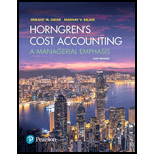
Direct materials and manufacturing labor variances, solving unknowns. (CPA, adapted) On May 1, 2017, Bovar Company began the manufacture of a new paging machine known as Dandy. The company installed a
| Direct materials (3 lb. at $4 per lb.) | $12.00 |
| Direct manufacturing labor (1/2 hour at $20 per hour) | 10.00 |
| Manufacturing |
7.50 |
| $29.50 |
The following data were obtained from Bovar’s records for the month of May:
| Debit | Credit | |
| Revenues | $125,000 | |
| Accounts payable control (for May’s purchases of direct materials) | 55,000 | |
| Direct materials price variance | $3,500 | |
| Direct materials efficiency variance | 2,400 | |
| Direct manufacturing labor price variance | 1,890 | |
| Direct manufacturing labor efficiency variance | 2,200 |
Actual production in May was 4,000 units of Dandy, and actual sales in May were 2,500 units.
The amount shown for direct materials price variance applies to materials purchased during May. There was no beginning inventory of materials on May 1, 2017 no beginning inventory of materials on May 1, 2017.
Compute each of the following items for Bovar for the month of May. Show your computations.
- 1. Standard direct manufacturing labor-hours allowed for actual output produced
Required
- 2. Actual direct manufacturing labor-hours worked
- 3. Actual direct manufacturing labor wage rate
- 4. Standard quantity of direct materials allowed (in pounds)
- 5. Actual quantity of direct materials used (in pounds)
- 6. Actual quantity of direct materials purchased (in pounds)
- 7. Actual direct materials price per pound
Want to see the full answer?
Check out a sample textbook solution
Chapter 7 Solutions
REVEL for Horngren's Cost Accounting: A Managerial Emphasis -- Access Card (16th Edition) (What's New in Accounting)
- Please answer the following requirements a and b on these general accounting questionarrow_forwardGeneral Accountingarrow_forwardHarper, Incorporated, acquires 40 percent of the outstanding voting stock of Kinman Company on January 1, 2023, for $210,000 in cash. The book value of Kinman's net assets on that date was $400,000, although one of the company's buildings, with a $60,000 carrying amount, was actually worth $100,000. This building had a 10-year remaining life. Kinman owned a royalty agreement with a 20-year remaining life that was undervalued by $85,000. Kinman sold Inventory with an original cost of $60,000 to Harper during 2023 at a price of $90,000. Harper still held $15,000 (transfer price) of this amount in Inventory as of December 31, 2023. These goods are to be sold to outside parties during 2024. Kinman reported a $40,000 net loss and a $20,000 other comprehensive loss for 2023. The company still manages to declare and pay a $10,000 cash dividend during the year. During 2024, Kinman reported a $40,000 net income and declared and paid a cash dividend of $12,000. It made additional inventory sales…arrow_forward
- Solve this general accounting question not use aiarrow_forwardPlease provide solution this general accounting questionarrow_forwardMichael McDowell Co. establishes a $108 million liability at the end of 2025 for the estimated site-cleanup costs at two of its manufacturing facilities. All related closing costs will be paid and deducted on the tax return in 2026. Also, at the end of 2025, the company has $54 million of temporary differences due to excess depreciation for tax purposes, $7.56 million of which will reverse in 2026. The enacted tax rate for all years is 20%, and the company pays taxes of $34.56 million on $172.80 million of taxable income in 2025. McDowell expects to have taxable income in 2026. Assuming that the only deferred tax account at the beginning of 2025 was a deferred tax liability of $5,400,000, draft the income tax expense portion of the income statement for 2025, beginning with the line "Income before income taxes." (Hint: You must first compute (1) the amount of temporary difference underlying the beginning $5,400,000 deferred tax liability, then (2) the amount of temporary differences…arrow_forward
 Managerial Accounting: The Cornerstone of Busines...AccountingISBN:9781337115773Author:Maryanne M. Mowen, Don R. Hansen, Dan L. HeitgerPublisher:Cengage Learning
Managerial Accounting: The Cornerstone of Busines...AccountingISBN:9781337115773Author:Maryanne M. Mowen, Don R. Hansen, Dan L. HeitgerPublisher:Cengage Learning
